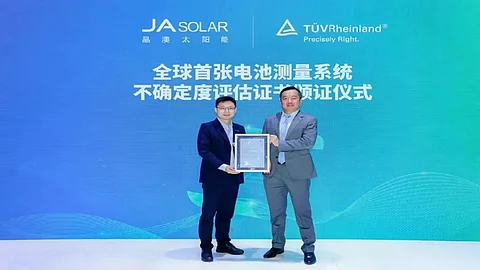

Leading integrated solar manufacturer JA Solar has received the ‘world’s first’ certificate for solar photovoltaic cell power measurement uncertainty assessment, issued by TÜV Rheinland, for its R&D laboratory in Shanghai. The certification focuses on the laboratory’s PV cell power measurement system under standard test conditions (STC).
The company said that the assessment, based on relevant IEC standards, involved a comprehensive evaluation of the lab’s hardware performance, measurement procedures, quality management system, and personnel expertise. The results confirmed that the STC power measurement uncertainty (at a coverage factor k=2) of the lab is below 2%, marking a leading level in the global solar cell measurement field.
JA Solar recently announced that its n-type TOPCon DeepBlue module has reached a conversion efficiency of 25.5% with a front-side power output exceeding 700 W (see China Solar PV News Snippets).
Smart manufacturing solutions provider LEAD Intelligent has announced that it has delivered a turnkey perovskite solar cell production line to a leading solar company in Shanghai. The company says the line integrates all major processing steps, including substrate cleaning, laser scribing, coating, PVD (physical vapor deposition), ALD (atomic layer deposition), evaporation, annealing, vacuum crystallization, and encapsulation, thus offering full-process coverage from cell fabrication to module assembly.
LEAD emphasized that core systems such as the PVD equipment, ALD system, evaporation chamber, laser scribing tools, and a 3-part coating suite were all independently developed in-house.
Integrated solar manufacturer Tongwei Solar announced last week that its cumulative module shipments reached 100 GW as of June 2025. The company said that it has achieved this feat in the period spanning August 2022 to June 2025. The company, however, did not share details such as figures for exports by region, by module type, etc.
On the technology and performance front, during the recent TaiyangNews PV System Technology Trends Conference 2025, Aran Huang, from Tongwei Solar’s Overseas Technical Support team, said that Tongwei’s targets to achieve a cell efficiency of 26.5% with its upgraded TNC 2.0 technology (see Innovation Drives Solar PV Forward Despite Market Headwinds).
The Solar PV Robot Application Alliance has officially released a white paper titled Smart Collaboration Among Modules, Mounting Systems, and Cleaning Robots. Initiated by robotic cleaning solutions provider Sunpure and compiled under the guidance of the China Photovoltaic Industry Association (CPIA), the white paper was jointly authored by TÜV SÜD, LONGi, JinkoSolar, JA Solar, Astronergy, Arctech, and others.
According to Sunpure, the white paper provides an in-depth analysis of the current state and technological evolution of intelligent cleaning robots and their integration with PV systems. It also presents practical solutions for improving performance validation, innovation in product development, and system-level synergy.
The Changchun Institute of Applied Chemistry, part of the Chinese Academy of Sciences, has announced a breakthrough in developing a new radical-based self-assembling molecular material for use in perovskite solar cells. The innovation significantly enhances the performance of the hole transport layer (HTL) and addresses challenges related to uniform large-area film deposition.
The technology has been certified by the US National Renewable Energy Laboratory (NREL) and published in the journal Science. According to the institute, electrochemical scanning microscopy demonstrated that the new material enables carrier transport rates more than twice those of conventional materials, with virtually no degradation after thousands of hours of continuous operation. The material exhibits superior self-assembling behavior, forming highly uniform thin films and overcoming losses caused by disordered stacking in traditional HTL materials.
